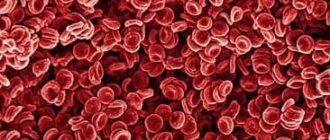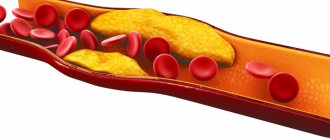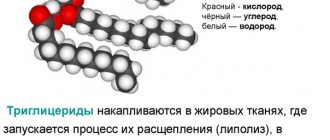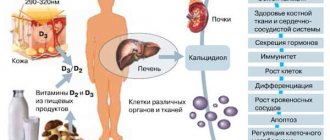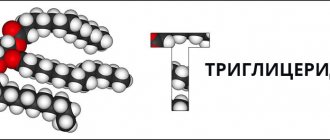What are lipoproteins?
Not all blood cholesterol is equally dangerous: sometimes they talk about “good” and “bad” cholesterol. But cholesterol as a substance is all the same, it is simply found in the blood in different spherical particles - complexes with other fat and protein molecules - they are called lipoproteins.
Some of them, low-density lipoproteins, carry cholesterol in the blood to peripheral tissues from the liver, where it is synthesized. If too many of these particles are formed or their breakdown is impaired, a lot of cholesterol accumulates in the blood, it is deposited in the walls of blood vessels, and connective (scar) tissue grows around its deposits. This is how an atherosclerotic plaque is formed, narrowing the lumen of the vessel and impeding blood flow. And then the cholesterol in low-density lipoproteins can be called “bad”.
There are different types of atherosclerotic plaques. The most malignant ones, with a large cholesterol core and a thin cap of connective tissue, are called unstable. Such a plaque ruptures easily and opens like an abscess into the lumen of the vessel. In response to this, the body tries to close the resulting damage with a blood clot. Often the thrombus cannot stop growing and closes, like a plug, the entire lumen of the vessel. The blood flow stops, and the organ tissue dies without oxygen and nutrients. If this happens in the heart, a myocardial infarction develops; if it happens in the brain, a cerebral stroke occurs. As can be seen from the above, the onset of such dangerous diseases is caused by an increased level of cholesterol, which is found in low-density lipoproteins. That is why it is called “bad”. In a detailed laboratory analysis of blood lipids (fats and fat-like substances), this indicator is abbreviated as LDL cholesterol.
But there are others in the blood - “good” lipid-protein complexes. They are called high-density lipoproteins (HDL). HDL captures and removes cholesterol from where it accumulates in the walls of blood vessels. By “cleansing” blood vessels of excess cholesterol, HDL prevents the formation of atherosclerotic plaques.
The higher the level of LDL cholesterol (cholesterol in the “bad” complexes) in the blood and the lower the level of HDL cholesterol (cholesterol in the “good” complexes), the faster atherosclerosis will develop.
Cardiologists around the world are of the opinion that every person over 20 years of age should know their cholesterol level. Moreover, it is necessary to do a blood test for “good” and “bad” cholesterol, i.e. detailed lipid analysis.
Our Center operates a lipid clinic, so in the clinical diagnostic laboratory you can do a detailed analysis of your lipid profile, and also contact a lipidologist, a specialist who will competently advise you based on the results of laboratory tests. Depending on the level of cholesterol and its distribution in “bad” and “good” complexes, as well as according to other examinations, the doctor decides on the need for dietary or drug correction and gives appropriate recommendations.
You can make an appointment with a lipidologist by calling: +7 (495) 790-71-72
Categories of lipoproteins
Molecules loaded with cholesterol are much larger than those that lack it. The mass of cholesterol affects the density of the molecule. The higher the mass, the greater the density. According to the level of density, lipoproteins are divided into the following categories:
LDL cholesterol - what is it?
- Chylomicrons. What it is? Molecules of a super-volumetric structure that are formed in the intestines and disintegrate in the circulatory system under the influence of a certain category of enzymes on cholesterol and the residue utilized by the liver. Chylomicrons are able to ensure the fullest degree of digestibility of cholesterol in the intestine.
- Extremely low density lipoproteins are similar to chylomicrons. The main difference is the transportation of cholesterol by lipoproteins, which is formed in the liver, and not what is absorbed into the digestive tract. Once in the circulatory system, this category of lipoproteins begins to break down into low-density lipoproteins, which release cholesterol for the needs of the tissue.
- Low-density lipoproteins (LDL) are the main carriers of cholesterol in the body. Despite their lightness and mobility, lipoproteins are capable of carrying a large percentage of cholesterol. The transformation of this category of lipoproteins from the previous one occurs through the stage of intermediate-density lipoproteins. The latter are not able to perform significant functions in the body due to their short lifespan.
- High-density lipoproteins (HDL) are among the fastest and lightest compounds of transport proteins and cholesterol. The compound is able to be synthesized in the liver and transport cholesterol in the blood plasma. There were no significant differences in functioning between low- and high-density lipoproteins.
High blood cholesterol may be a consequence of taking sex hormones or contraceptives
A disturbance in the exchange of HDL and LDL should be a reason to visit a doctor.
What do beta lipoproteins do?
The main purpose of lipoproteins is considered to be the transportation of cholesterol in the body. However, in addition to this, they take an active part in the transport of carotenoids and triglycerides. Due to the dissolution of beta lipoproteins in the blood plasma, a precipitate is formed, which begins to settle on the walls of blood vessels.
With a normal amount of cholesterol in the body, the sediment can be independently processed and removed from the circulatory system. With elevated cholesterol levels, atherosclerotic plaques begin to appear and grow, leading to stroke and heart attack.
References
- ESC/EOA Clinical Guidelines for the Diagnosis and Treatment of Dyslipidaemias, 2021.
- Russian recommendations VI revision. Diagnosis and correction of lipid metabolism disorders for the prevention and treatment of atherosclerosis, 2021.
- NCEP Expert Panel on detection, evaluation and treatment of high blood cholesterol in adults. Executive summary of the third report of the National Cholesterol Education Program (NCEP) Expert Panel on detection, evaluation and treatment of high blood cholesterol in adults (Adult Treatment Panel III). JAMA 2001;285:2486–2497.
Removing cholesterol from the body
The classic route of cholesterol elimination is cholesterol transport from the periphery to the liver (HDL), uptake by liver cells (SR-BI), excretion into bile and excretion through the intestine, where most of the cholesterol is returned to the blood [10].
The main function of HDL is the reverse transport of cholesterol to the liver. Plasma HDL is the result of a complex of different metabolic events. The composition of HDL varies greatly in density, physicochemical properties and biological activity. These are spherical or disc-shaped formations. Disc-shaped HDL is mainly composed of apoprotein AI with an embedded layer of phospholipids and free cholesterol. Spherical HDL is larger and additionally contains a hydrophobic core of cholesteryl esters and small amounts of triglycerides.
In metabolic syndrome, the exchange of triglycerides and cholesterol esters between HDL and triglyceride-rich lipoproteins is activated. As a result, the content of triglycerides in HDL increases, and cholesterol decreases (i.e., cholesterol is not excreted from the body) [11]. The absence of HDL in humans occurs in Tangier disease, the main clinical manifestations of which are enlarged orange tonsils, corneal arch, infiltration of bone marrow and mucosal layer of the intestine [3].
To briefly summarize, it is not cholesterol itself that is scary, which is a necessary component that ensures the normal structure of cell membranes and the transport of lipids in the blood, but in addition it is a raw material for the production of steroid hormones. Metabolic disorders manifest themselves when the balance of LDL and HDL is disturbed, which reflects a disruption of the lipoprotein transport system, including liver function, bile formation and the participation of macrophages. Therefore, any liver diseases, as well as autoimmune processes, can cause the development of atherosclerosis, even with a vegetarian diet. If we return to the original experiments of N.A. Anichkov on feeding rabbits with food rich in cholesterol, we will see that cholesterol is not found in the natural diet of rabbits and therefore, like a poison, disrupts the functioning of the liver, causes severe inflammation of blood vessels and, as a result, the formation of plaques.
Restoring this balance artificially (for example, at the molecular level using nanoparticles) will someday become the main method of treating atherosclerosis (see “Nanoparticles for “bad” cholesterol!” [13]). - Ed.
Lipoprotein(a) levels in different populations
The level of Lp(a) in the blood is determined genetically - the length of the gene encoding the apolipoprotein Apo(a). As indicated, in the human population there are many alleles (different variants) of the apolipoprotein Apo(a) gene that encode different numbers of kringle IV domains. In general, Lp(a) concentrations can range from <0.1 to >200 mg/dL between individuals and vary up to 1000-fold. Africans are characterized by an increased concentration of Lp(a), which is on average 7 times higher than the level of Lp(a) in European and Asian populations.
Beginning in early childhood, the concentration of lipid(a) increases, reaches a plateau in adulthood and then remains virtually unchanged. A further increase in Lp(a) levels is observed only in postmenopausal women.
Treatment
Because Lp(a) levels are genetically determined, it is virtually impossible to lower them through diet changes, weight loss, or commonly used medications (statins).
Some positive effects have been noted with the use of nicotinic acid and hormone replacement therapy, but these data need serious confirmation.
Drugs that lower Lp(a) levels are not yet known, so it is unknown whether lowering Lp(a) levels will reduce cardiac risk.
There are observations that at elevated levels of lipoprotein(a), some vitamins and amino acids have some effectiveness: vitamin C, vitamin B3, lysine, proline, N-acetylcysteine, but certain treatment regimens have not been developed and these treatment methods require serious clinical confirmation.
Currently, methods for reducing hyper-LP(a) such as cascade plasma filtration and immunosorption are actively used.
The role of lipoprotein (a) in pathology
High levels of Lp(a) are a risk factor for coronary heart disease, atherosclerosis, thrombosis and stroke. A high level of Lp(a), like a high level of LDL, predicts the risk of developing early atherosclerosis. Since Lp(a) is structurally very close to plasminogen, Lp(a) has a high affinity for the extracellular matrix and quickly accumulates in the vascular wall. Subsequently, the protein undergoes oxidation and partial proteolysis under the action of metalloproteases, which causes the development of atheromatous plaque.
Lp(a) has a high affinity for fibronectin and forms complexes with proteoglucans and glucosaminoglucans of the extracellular matrix. This leads to selective accumulation of lipoprotein(a) in the walls of blood vessels and to the induction of the inflammatory process. Moreover, Lp(a) is an adhesive substrate for monocytes and activates inflammatory cells. A mitogenic effect of LP(a) on human smooth muscle cells, stimulating their growth, was also discovered. Lipoprotein(a) also competes with plasminogen for binding sites on the cell surface, reducing plasminogen activation and inhibiting the lysis of blood clots.
Unlike most lipid risk factors, the risk associated with elevated Lp(a) levels is independent of age, sex, diet, and living conditions. However, as it turned out, factors that can increase Lp(a) levels still exist. As mentioned, Lp(a) catabolism occurs in the kidneys. Renal pathologies increase the level of lipoprotein(a) due to reduced catabolism of its particles.
It has been found that in individuals suffering from chronic renal failure, nephrotic syndrome and diabetic nephropathy, as well as in patients on hemodialysis, Lp(a) levels are significantly increased. It is natural that during remission of nephrotic syndrome, Lp(a) levels decreased.
It is important that apolipoprotein Apo(a) is an acute phase protein (AP) of inflammation and its concentrations can increase after surgery, myocardial infarction, stroke and other tissue damage.
Despite decades of persistent research, the normal physiological role of Lp(a) is still not clearly understood. It is believed that Lp(a) is either somehow involved in the metabolism of cholesterol and triglycerides (because it is similar to LDL), or takes some part in the coagulation processes, because the apolipoprotein Apo(a) is similar to plasminogen. Or both together. LP(a) is not vital. Individuals with practically zero or vanishingly low concentrations do not have noticeable pathologies.
Lp(a) levels can vary up to 1000-fold between individuals. It is assumed that LP(a) accelerates wound healing, promotes the restoration of damaged tissues and damaged blood vessels. This hypothesis is based on the fact that Lp(a) is a positive reactant of OF and on the fact that it recognizes a large number of receptors located on the surface of endothelial cells, macrophages, fibroblasts and platelets. Lp(a) also binds to various components of the vascular wall and subendothelial matrix and increases the proliferation of smooth muscle cells.
In general, Lp(a) is a risk factor and predictor of:
- hereditary predisposition to cardiovascular and microvascular diseases
- genetically mediated acute coronary events
- genetically mediated ischemic strokes
Lp(a) levels should be measured:
- in patients with early cases of CVD
- in those with a family history of frequent cases of CVD (suspicious genetic predisposition)
- in those diagnosed with CVD and who do not have traditional risk factors
- in those whose hypercholesterolemia does not improve with statin therapy
- in patients with renal diseases
- in those prescribed angioplasty
- in those who are prescribed coronary artery bypass grafting
- for diabetes mellitus type 1 and 2
Reference values of LP(a):
- target level <14 mg/dL
- borderline risk 14-30 mg/dl
- high risk 31-50 mg/dL
- very high risk >50 mg/dL
Factors that increase results:
- insulin deficiency
- low free thyroxine levels
Factors that reduce the result:
- estrogens
- stanozolol
- niacin
- neomycin
- N-acetylcysteine
- Omega-3 fatty acids (fish oil)
Treatment of elevated beta lipoprotein levels
When prescribing therapy, the doctor must take into account the individual characteristics of the body. It is not advisable to use medications when the level of lipoproteins is at the permissible limit or slightly exceeds it.
In this case, the following will help restore health:
- Proper nutrition, excluding dishes containing significant amounts of animal fat. You will have to exclude the consumption of fatty meat, cheese, chips, fried potatoes, pizza, ice cream, sausage and various confectionery products. The listed products must be replaced with horse meat, rabbit, turkey, tilapia and plenty of fresh vegetables and fruits.
- Peanuts and almonds, oats and barley, and legumes help lower cholesterol.
- Systematic sports activities. Slow evening walks in the fresh air are very useful.
- Drink 2-2.5 liters of clean water per day.
- Complete elimination of bad habits. Alcohol-containing drinks and smoking contribute to increased cholesterol.
By following all the doctor’s recommendations, you can quickly restore your health. If there is an increase in lipoproteins, medications that contain a statin and help block the production of compounds by the liver may be prescribed. Treatment will also be required in cases where the levels are low.
Cascade plasmafiltration
The principle of the cascade plasma filtration procedure is that the blood plasma separated on the primary plasma filter enters the internal chamber of the plasma fractionator. Molecules with large molecular weight (atherogenic low- and very low-density lipoproteins (LDL, VLDL), lipoprotein (a) (Lp(a)), autoantibodies and circulating immune complexes, etc.) present in plasma are cut off due to their large size porous filter located inside the plasma fractionator.
Plasma components that can pass through the pores of the filter material pass through the porous material and, combining with blood cells, are returned to the patient.
The clinical effects of cascade plasma filtration procedures are associated with the direct removal of pathogenic components from the blood of patients and with a significant improvement in blood microcirculation. Purified blood plasma, due to the difference in concentrations, promotes the release of harmful substances accumulated there from the tissues, for example, cholesterol from an atherosclerotic plaque. Therefore, repeated procedures for cascade filtration of plasma lead to the gradual purification of not only the blood, but also the body tissues, and the dissolution of atherosclerotic plaques.
Cascade plasmafiltration procedures are used in the treatment of atherosclerosis, complications of diabetes, maculopathy, sensorineural hearing loss, allergies, some forms of miscarriage, and a number of other diseases.

